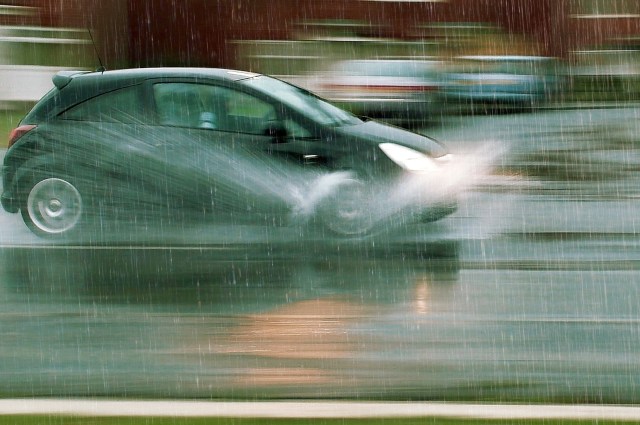Everyone knows to drive slowly on ice to avoid skidding. But driving through water can be just as hazardous, and if you are not careful, can cause a car to slide off the road.
What Is Hydroplaning?
You’ve probably heard the term before, but what exactly does it mean?
Hydroplaning occurs when a thin layer of water comes between the tires and the road. Suddenly the tires have no traction, the driver has no control of the car and is in danger of sliding off the road or into oncoming traffic. All this happens in a matter of seconds.
Cars are at greatest risk for hydroplaning during the first 10 minutes of a downpour because tires can’t quickly displace enough water from their treads. Drivers traveling 40 mph or more through water more than one-tenth of an inch deep have a higher chance of hydroplaning.
What to Do When Hydroplaning
If your car starts to hydroplane, release the accelerator slowly, said AAA’s Car Doctor John Paul. Quick deceleration or sudden steering maneuvers can put the car into a skid. Hold the steering wheel firmly and keep the front of the car pointed straight ahead. Steer gently to keep the car going forward and take your foot off the gas pedal so the car slows down on its own.
How to Avoid Hydroplaning
To prevent your car from hydroplaning, Paul said:
- Watch the roadway; look for pooling water and big puddles. Monitor your car’s speed. “The faster your car is traveling, the more likely you are to hydroplane.”
- Leave extra following distance between you and the traffic ahead. This will give you more time to react.
- Ensure your tires are fully inflated and have adequate tread. AAA recommends replacing tires when the tread gets down to 4/32nds inches of tread (2/32nd inches is the minimum legal tread depth in most states).
A legal tire with 3/32nd inches of tread can take up to 225 feet to stop from 60 mph, while a tire with 5/32nd inches of tread will take 195 feet. “That 30-foot difference can be the difference between a crash and one that didn’t happen,” Paul said.
Has your car ever hydroplaned? What helped you recover? Tell us in the comments.
4 Thoughts on “What Is Hydroplaning?”
Leave A Comment
Comments are subject to moderation and may or may not be published at the editor’s discretion. Only comments that are relevant to the article and add value to the Your AAA community will be considered. Comments may be edited for clarity and length.

















I hydroplaned 40 years ago and never forgot the experience. I was on the NY Thruway going South in a heavy rain. I was going my normal speed as I had no information about hydroplaning (never was told about it) and suddenly my car slid smoothly on the water, as if in a boat on a lake). I slid to the right and my car turned around to face the traffic, I kept sliding until I came to rest on the right shoulder, a few inches from the guardrail facing traffic. I was very lucky that the traffic was far enough behind me so it did not get very close until I sat on the shoulder facing it.
It is important to recognize that there was no warning of any kind. One minute I was driving South and the next minute I was sliding (I don’t use “skidding” as it was so smooth that “sliding” describes it better). When I was able to turn the car around and continue my trip South, I stayed at 40 or 50 MPH and did not have another such incident.
I hope this is helpful for those who don’t know about hydroplaning and would not conceive of their vehicle suddenly sliding on the water beyond the driver’s control.
Bob
It is advisable not to use Cruise Control in heavy rain, as you will be less likely to detect Hydroplaning.
I hydroplaned a number of years ago and began to skid. Thankfully I remembered to turn into the skid (it’s counterintuitive) and also removed my foot from the accelerator. There was not much traffic on that highway, so I was able to recover without impeding the flow of traffic.
I hydroplaned badly after driving a number of highway miles in a downpour when slowing down for a toll booth. As I applied the brakes the car just kept going as if it were on black ice, so I very gently applied the brakes and was able to slow down and stop in time. The car stayed in control. Later I was advised to brake every now and then during a downpour to keep the brakes dry, which is what I do now.